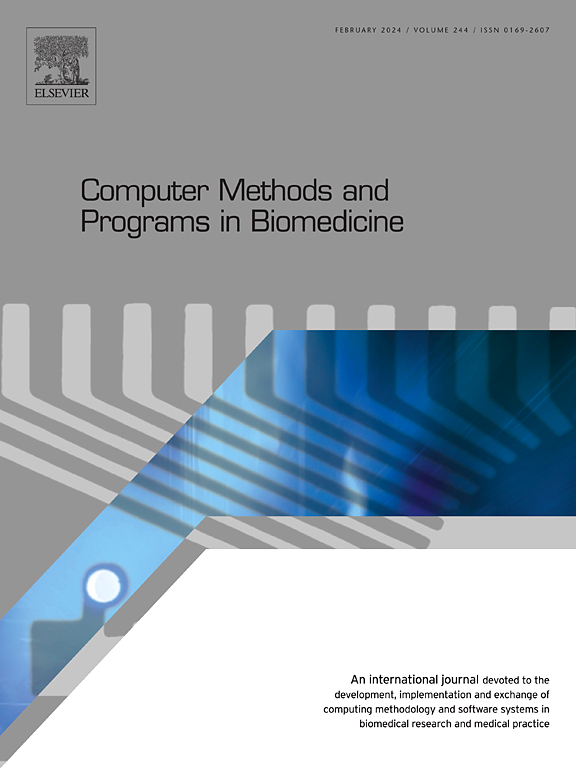基于cta的闭环冠状动脉血流模拟与血管内多普勒速度和压力测量的验证
IF 4.9
2区 医学
Q1 COMPUTER SCIENCE, INTERDISCIPLINARY APPLICATIONS
引用次数: 0
摘要
背景和目的使用冠状动脉计算机血管造影(CTA)进行冠状动脉计算流体动力学(CFD)模拟的建模假设尚未得到彻底验证。这些建模假设可能导致模拟速度和压力的不确定性,从而导致其他血流动力学标记,如壁面剪切应力的不确定性。在这项研究中,我们针对血管内多普勒速度和压力测量验证了最先进的冠状动脉CTA-CFD模拟策略。方法采用冠状动脉CTA重建13例患者的三维冠状动脉模型。在120±55个心动周期内获得18条动脉的血管内多普勒速度和压力,以验证CTA-CFD模拟。通过调整集总参数网络(LPN)来捕获每个患者的心脏和远端冠状动脉循环,并与CFD求解器耦合。对于每个患者,Murray 's Law系数从2.0到3.0变化,增量为0.2。模拟的速度和压力与血管内测量结果进行了比较。结果血管内血流参数与CTA-CFD参数的相关性与血流速度(r=-0.13, p = 0.60)无统计学意义,血流速率(r= 0.77, p <;0.01)和压力(r = 0.88, p <;0.01),相关性强,有统计学意义。当考虑有创测量中患者周期间的变异性时,18个冠状动脉中11个的流速和18个冠状动脉中7个的压力在血管内测量变异性的一个标准差内。结论cta - cfd模拟显示血管内流量和压力具有统计学意义,而流速无统计学意义。这些发现突出了测量变异性和建模假设的影响。未来的研究应考虑CTA-CFD固有的不确定性,特别是在估计绝对血流动力学参数(如速度和压力)时,并致力于完善边界条件和验证策略以提高准确性。本文章由计算机程序翻译,如有差异,请以英文原文为准。
Validation of CTA-based closed-loop coronary artery flow simulations against intravascular Doppler velocity and pressure measurements
Background and Objectives
The modeling assumptions involved in computational fluid dynamics (CFD) simulations of coronary arteries using coronary computed angiography (CTA) have not been thoroughly validated. These modeling assumptions can lead to uncertainties in simulated velocities and pressure, and consequently, other hemodynamic markers, such as wall shear stresses. In this study, we validated a state-of-the-art coronary CTA-CFD simulation strategy against intravascular Doppler velocity and pressure measurements.
Methods
3D coronary models were reconstructed using coronary CTA in 13 patients. Intravascular Doppler velocities and pressures were obtained in 18 arteries over 120 ± 55 cardiac cycles to validate CTA-CFD simulations. A lumped parameter network (LPN) was tuned to capture each patient’s heart and distal coronary circulation, and coupled to the CFD solver. For each patient, Murray’s Law coefficient was varied from 2.0 to 3.0 in increments of 0.2. The simulated velocities and pressures were compared to intravascular measurements.
Results
The correlation between intravascular and CTA-CFD parameters showed no statistically significant correlation for velocity (r=-0.13 and p = 0.60), while both flow rates (r = 0.77, p < 0.01) and pressures (r = 0.88, p < 0.01) demonstrated strong correlation and statistical significance. When considering the intra-patient cycle-to-cycle variabilities in invasive measurements, velocity in 11 of 18 and pressures in 7 of 18 coronary arteries were within one standard deviation of intravascular measurement variability.
Conclusion
CTA-CFD simulations showed statistically significant correlations for intravascular flows and pressures, whereas no meaningful correlation was observed for velocity. These findings highlight the influence of measurement variability and modeling assumptions. Future studies should consider the inherent uncertainties in CTA-CFD, especially when estimating absolute hemodynamic parameters such as velocity and pressure, and aim to refine boundary conditions and validation strategies to improve accuracy.
求助全文
通过发布文献求助,成功后即可免费获取论文全文。
去求助
来源期刊

Computer methods and programs in biomedicine
工程技术-工程:生物医学
CiteScore
12.30
自引率
6.60%
发文量
601
审稿时长
135 days
期刊介绍:
To encourage the development of formal computing methods, and their application in biomedical research and medical practice, by illustration of fundamental principles in biomedical informatics research; to stimulate basic research into application software design; to report the state of research of biomedical information processing projects; to report new computer methodologies applied in biomedical areas; the eventual distribution of demonstrable software to avoid duplication of effort; to provide a forum for discussion and improvement of existing software; to optimize contact between national organizations and regional user groups by promoting an international exchange of information on formal methods, standards and software in biomedicine.
Computer Methods and Programs in Biomedicine covers computing methodology and software systems derived from computing science for implementation in all aspects of biomedical research and medical practice. It is designed to serve: biochemists; biologists; geneticists; immunologists; neuroscientists; pharmacologists; toxicologists; clinicians; epidemiologists; psychiatrists; psychologists; cardiologists; chemists; (radio)physicists; computer scientists; programmers and systems analysts; biomedical, clinical, electrical and other engineers; teachers of medical informatics and users of educational software.
 求助内容:
求助内容: 应助结果提醒方式:
应助结果提醒方式:


